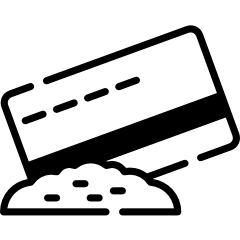

To explore this issue, we conducted extensive tests to determine which non-cannabinoid compounds are present in street cannabis. Through a call on the platform "Reddit", we were able to recruit enough volunteers willing to submit their black-market cannabis for analysis. The cannabis was sent to our research team using a sealed test kit, complete with location information and a timestamp.
Only one in five samples classified as "clean"
After eight months of work and with the fantastic support of over 200 volunteers, the submitted samples were tested for biological components, pesticides, and other drugs.* And the results were shocking: Out of more than 300 samples tested, only around 20 percent were classified as safe and clean products. The majority of the remaining 80 percent contained traces of substances such as human and animal feces, Covid-19, and influenza viruses. We also found traces of cocaine, ketamine, crystal meth, MDMA, and even compounds from hairspray, as well as traces of toxic pesticides that are classified as illegal in Europe.
Worst test results in Berlin, Hamburg, and Munich
How the individual cities performed in the study is shown in the following overview, listed in descending order from most to least contaminated samples from 30 German cities and 20 other European metropolises.
*Please see below for detailed information on the analysis methodology.





| # | City | Number of tests | Paclobutrazol | Chlorfenapyr | Trifloxystrobin | Cocaine | MDMA | Ketamine | Crystal Meth | Hair Spray | Pymetrozine | Human Feces | E Coli | Covid 19 | Rhinovirus | Influenza | Clean Samples |
|---|---|---|---|---|---|---|---|---|---|---|---|---|---|---|---|---|---|
| 1 | Berlin | 10 | x | x | x | x | x | x | x | x | x | x | x | 3 | |||
| 2 | Hamburg | 10 | x | x | x | x | x | x | x | 2 | |||||||
| 3 | Munich | 10 | x | x | x | x | x | x | x | x | 5 | ||||||
| 4 | Cologne | 10 | x | x | x | x | x | 4 | |||||||||
| 5 | Frankfurt am Main | 10 | x | x | x | x | x | x | 3 | ||||||||
| 6 | Stuttgart | 10 | x | x | x | x | x | x | x | 2 | |||||||
| 7 | Dusseldorf | 10 | x | x | x | x | x | x | x | 3 | |||||||
| 8 | Leipzig | 10 | x | x | x | x | 4 | ||||||||||
| 9 | Dortmund | 5 | x | x | x | x | 2 | ||||||||||
| 10 | Essen | 5 | x | x | x | x | x | 3 | |||||||||
| 11 | Bremen | 5 | x | x | x | x | 1 | ||||||||||
| 12 | Dresden | 5 | x | x | x | x | x | 1 | |||||||||
| 13 | Hanover | 5 | x | x | x | x | x | 3 | |||||||||
| 14 | Nuremberg | 5 | x | x | x | x | x | x | x | 2 | |||||||
| 15 | Duisburg | 3 | x | x | x | x | 1 | ||||||||||
| 16 | Bochum | 3 | x | x | x | x | 1 | ||||||||||
| 17 | Wuppertal | 3 | x | x | x | x | x | 0 | |||||||||
| 18 | Bielefeld | 3 | x | 1 | |||||||||||||
| 19 | Bonn | 3 | x | x | x | x | x | 1 | |||||||||
| 20 | Münster | 3 | x | x | x | 2 | |||||||||||
| 21 | Mannheim | 3 | x | x | x | x | 0 | ||||||||||
| 22 | Karlsruhe | 3 | x | x | x | x | 0 | ||||||||||
| 23 | Augsburg | 2 | x | x | 0 | ||||||||||||
| 24 | Wiesbaden | 2 | x | x | 0 | ||||||||||||
| 25 | Mönchengladbach | 2 | x | x | x | 1 | |||||||||||
| 26 | Gelsenkirchen | 2 | x | x | x | x | x | 0 | |||||||||
| 27 | Aachen | 2 | x | x | 1 | ||||||||||||
| 28 | Braunschweig | 2 | x | 1 | |||||||||||||
| 29 | Chemnitz | 2 | x | x | x | x | x | x | x | 0 | |||||||
| 30 | Mainz | 2 | x | x | 1 | ||||||||||||
| 31 | London | 10 | x | x | x | x | x | x | x | x | x | x | x | 4 | |||
| 32 | Madrid | 10 | x | x | x | x | x | x | x | 3 | |||||||
| 33 | Lisbon | 5 | x | x | x | x | x | x | 1 | ||||||||
| 34 | Barcelona | 5 | x | x | x | x | x | x | x | x | 2 | ||||||
| 35 | Paris | 10 | x | x | x | x | x | x | x | 0 | |||||||
| 36 | Manchester | 5 | x | x | x | x | x | x | 2 | ||||||||
| 37 | Brussels | 5 | x | x | x | x | x | x | 0 | ||||||||
| 38 | Viena | 5 | x | x | x | x | x | x | x | x | 2 | ||||||
| 39 | Zurich | 5 | x | x | x | x | 2 | ||||||||||
| 40 | Geneva | 5 | x | x | x | x | x | x | 3 |
